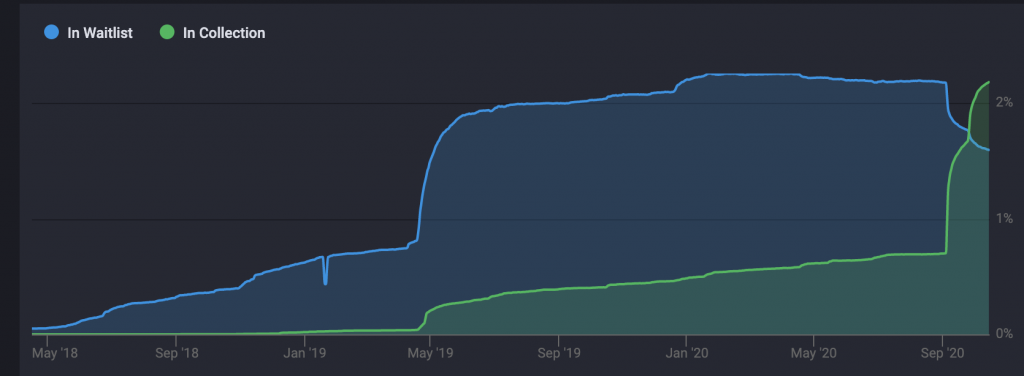
After your game launches on Steam there is a strange cyclical sales behavior that emerges. Every 8 weeks you can put your game on sale. When you do it triggers an email to everyone who wishlisted your game, which causes some of them to buy it. All those new purchases and lower prices encourages the Steam algorithm to show your game in more places which causes more people to wishlist it. Round and round that is very much how it goes.
It kind of reminds me of how this diagram of a pump works. (Gif credit)

If you could just keep discounting at 20% (the minimum required for the “wishlist” email to get triggered) you could just live off you game forever right?
Well, the reason people wishlist your game despite it already being on sale for a great price is because they are waiting for deeper discounts. Everyone has their price.
Did you know you can actually see (or at least an approximation – see footnote below) of how many people are waiting for you to deeply discount your game?
How to see what price fans are waiting for
The 3rd party site Is There Any Deal? allows people to name a price they want to pay for a game and the site will email them once that game is at least that price. Users can also pair their Steam API so isthereanydeal can track how many people own it. The interesting thing is isthereanydeal makes all their aggregated data public.
You get interesting charts like this one:

The blue area represents the people waiting for the game. The green shows how many people have it in their collection. When you look at that chart you can see there was a lot of pent up demand for the game until September 4th when the number of owners shot up dramatically and eclipsed the number of people waiting for the game. September 4th was the first time Forager was sold at that deep of a discount. (You can actually read the announce here)
Now I don’t know if that was the cause for the huge spike in owners but it seems as if a boundary was crossed and all of a sudden a lot of people who subscribe to isthereanydeal got the game.
Isthereanydeal also shows you what price various groups of people are waiting for with these great bar charts.
As you can see, 40% is the lowest price Forager has gone and a ton of people are waiting for the price to hit 50%. Then there is another spike at 75%. This chart makes it more clear how it is important to gradually stair-step your discounts. Go too deep in one sale and you gave away your game to a bunch of people who would have happily paid a lot more for your game.

You can look up your own game and you should have a good understanding of how your game fairs. Go to https://new.isthereanydeal.com/ type your game in the search bar Then click the “Stats” tab. (Note the “new” subdomain in the url which is the alpha site which is much more attractive).
It’s really interesting to see how other games have managed their sales.
Games that don’t discount frequently or deeply
In my research Steam users really only buy when their are sales. When you look at games like this one that doesn’t do many frequent sales you see very long and flat “In Collection” chart with an ocean of pent up demand.

Games that do frequent discounts
This chart is for Grand Theft Auto V. Notice how different this chart looks compared to the previous game that didn’t do that many discounts.
There is a smooth increase of “In Collection” while the waitlist is slowly bled out. This seems like a good way to manage a product over time. Slowly but surely capturing the pent up demand at the highest price possible.

Games that do frequent updates
The following chart is for Dead Cells. This game also has a slow but steady increase in owners and a slow but steady decrease in Waitlisters.

If you notice though, the owners of Dead Cells have never dropped the price on steam below 40%. I think they achieve their consistent sales through their frequent free content updates. Instead of discounting they basically add more value to their games which is technically like a discount but without changing the price.

Games that do infrequent huge discounts
The impressively successful Witness does very few sales but when it does them, they are very large. As you can see from this chart the “In Collections” line leaps up in huge stair steps.
The first jump occurs in February 2017 as part of the Humble Freedom Bundle which was an anti-Trump election donation charity bundle. So even presidential politics can affect your products!
The “In Collection” line overcomes the Waitlist line on July 6th. That is when the Witness was featured in a Daily Deal for 70% off (Which you can read here)

As you can see from The Witness chart compared to GTA V/Dead Cells charts a more frequent but gradual discount strategy can lead to more sustained growth as opposed to infrequent but significant discounts which cause stagnant but stair stepped growth. But if you want to discount your game to fund democracy I won’t stop you!
IsThereAnyDeal Footnote
**The data does not represent all of steam it just represents people who use isthereanydeal and have chosen to setup an alert.
**Also the accuracy of the game depends on its popularity. Smaller games have fewer followers so the sample size can throw off the percentages.